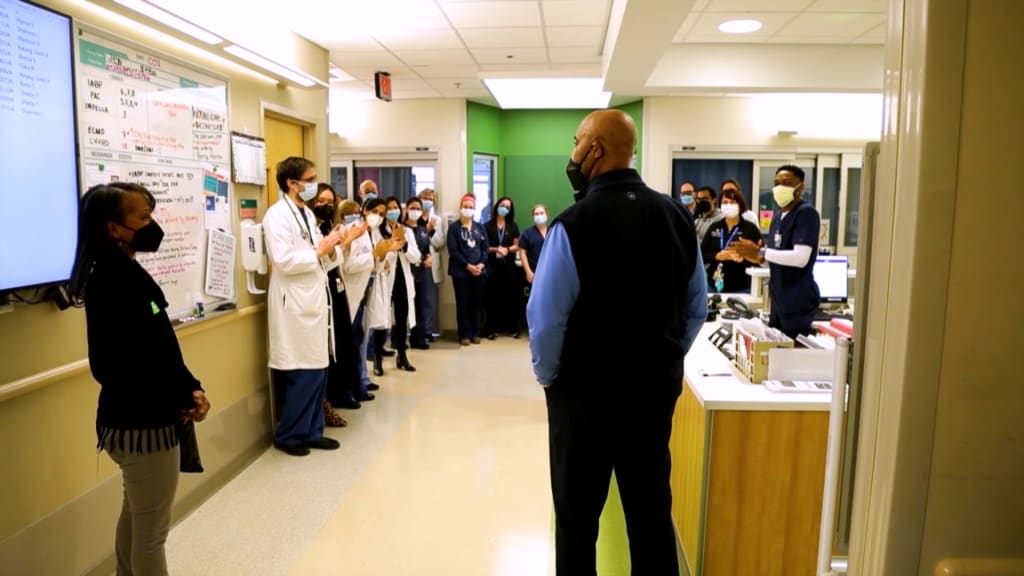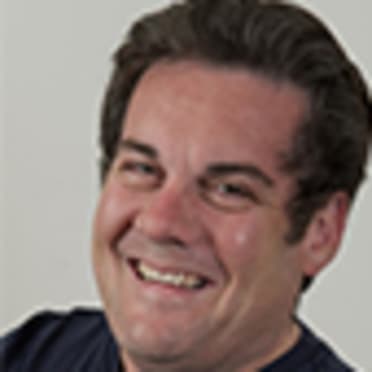CHICAGO -- Harold Baines has been part of more than 30 home openers as a Hall of Fame player, coach and ambassador for the White Sox organization.
When he arrives with his wife, Marla, at Guaranteed Rate Field on Tuesday morning for the 2022 home opener in Chicago, something will feel different. Baines, now 63, will arrive almost 11 months removed from a life-saving heart and kidney transplant surgery at Johns Hopkins Hospital in Baltimore.
Surviving and recovering from the surgery has provided Baines, a Maryland native, a new lease on life. But as he told MLB.com Thursday evening, the goal for Baines on that night simply was getting to Friday.
“Just focus on Tuesday when Tuesday comes,” Baines said. “I’m excited to get back after two years and not being there. Today, I just take it one day at a time.”
“It’s a second chance,” said Marla, who has been married to Harold for 37 years. The couple has four children and six grandchildren. “We would have taken an extra year or two. He’s back now almost like it never happened.”
As a player for 22 Major League seasons, Baines was as beloved as he was revered. The consummate professional finished with 384 home runs, 1,628 RBIs and 2,866 hits over 11,092 plate appearances. He was an outstanding defensive presence in right field early in his career with the White Sox, before becoming one of the game’s premier designated hitters.
Those two decades of baseball produced 10 knee surgeries and, ultimately, a right knee replacement, but nothing like what he endured almost a year ago. Baines had the heart replacement surgery --- an eight-hour procedure -- on May 20, 2021. The very next day, surgeons performed the kidney transplant.
“There’s nothing worse than this,” Baines said. “You are relying on somebody passing before you can live.”
“He’s a great guy,” said Dr. Ahmet Kilic, director, heart transplantation and associate professor of surgery for Johns Hopkins University, as well as Baines’ heart transplant surgeon. “He just smiled and was upbeat the whole time. His family was really supportive of him, and he really didn’t complain much.”
Baines learned four or five years ago that he had the familial amyloidosis trait from his father, Linwood Jr. The condition led to Linwood's death just as he was about to turn 78. The heredary condition, more common in people of African descent, results from a genetic mutation that produces an amyloid protein that forms into an abnormal shape. These abnormal “misfolded” amyloid proteins can be deposited and cluster in the body’s nerves and other organs and once they build up, this may affect and harm tissue and/or organ function.
Initially, there were no apparent symptoms aside from fluid buildup in his legs, but after being referred to Johns Hopkins, closer to his home, Baines underwent testing on Feb. 1, 2021. He received a call that same night telling him he needed to get into the hospital in two days. Baines' diagnosis was restrictive cardiomyopathy, according to Dr. Kilic. Due to the disease, Baines' heart could not relax appropriately.
Dr. Kilic's team evaluates how to best get a patient’s heart to recover. It usually starts with medications from the cardiologist, but when medications fail, other alternatives are considered.
“Three months later, I’m walking out with a donor heart and kidney,” Baines said.
Upon discovering the grave condition of Baines’ heart, Dr. Kilic implanted a balloon pump to help the blood circulate. The balloon pump wasn’t helping enough, and Baines was placed on an Extracorporeal Membrane Oxygenation Machine (ECMO), which pumps and oxygenates a patient's blood outside the body, allowing the heart and lungs to rest.
“I don’t want to sensationalize it, but it’s really one step away from death in many ways,” Dr. Kilic said. “The entire blood supply from your body is being shunted through these catheters and to this device that oxygenates and pumps blood, so it acts to both the right and left side of your heart, as well as your lungs.”
“Very very scary,” Marla said of the whole process leading to the transplant. “Two of our daughters are nurses, so we would always talk to them about what the doctors and nurses were doing, what they are describing. And they would always give us more information and help us out, which is good. Harold’s dad died from this disease because he didn’t really know what he had, had waited too long to figure out what was going on.”
Baines said he wasn’t scared because he trusted the process. It’s a mantra he has embraced, including during recovery.
“Some days, I did have bad days,” Baines said. “It was hard work even after you get the transplant, what you have to do. You have to learn how to eat again, you have to learn how to walk again. It’s still a journey, but I’m in a better place now.”
“Of course, you will have ups and down,” Dr. Kilic said. “It’s human nature for us to doubt things once in a while or to get down once in a while. But especially when you feel like you are making progress one day, and the next day we are going on to bigger machines ... he was very resilient.”
A heart became available five days after Baines was placed on ECMO, and the transplants were performed. According to Marla, the donor had to be between the ages of 18 to 39, had to be a male, and had to have the same blood type and the same height and weight as her husband.

Although he was up walking the next day and immediately in therapy, he could only take two steps at first and would have to sit down in a wheelchair. He signed a baseball for one of the many nurses taking care of him and could barely hold the ball. He then moved to 10 steps and was eventually walking the hallway two or three times.
Now Baines jokes that he never ran on the treadmill when he was healthy, but now he switches between the stationary bike, elliptical and treadmill for 30 to 40 minutes a day, six days a week. He mixes in some band work for strength training, but is avoiding any weights until he is a full year removed from surgery.
“I’m very thankful to the donor’s family for being on a donor’s card,” Baines said. “I have to stress how important it is to be a donor. I remember Ed Farmer [long-time White Sox broadcaster and Baines' ex-teammate] was big on donors, and we would do something downtown every year. Little did I would know I would need it one day.”
“He’s just a person that had a very quiet, gentle demeanor about him,” said Deb Carter, a heart transplant nurse who worked with Baines. “He was very focused on his recovery. He did everything the medical team recommended.”
Baines was released from the hospital on Father’s Day, with two of his grandchildren waiting at home to give the already special day an extra special meaning. Very few people knew about Baines’ surgeries and recovery, even some who are very close to him.
He was never a publicity seeker as a player -- actually, far from it. And this situation was about real life as opposed to home runs and RBIs.
“Yeah, it’s a personal experience,” Baines said. “I’m not looking for sympathy. We wanted to attack it as a family. You will probably see me doing more with donors and stuff like that in Chicago. It was unknown so ... we wanted to wait until a year before we told anybody. We just didn’t know. It’s been good so far.”
“He’s doing well,” Dr. Kilic said. “Overall, he’s doing wonderful. He’s back to enjoying life and being an ambassador both for baseball and organ transplantation.”
Baines began paying it forward long before April, National Donate Life month. Baines visited with an older gentleman who was just getting started at Johns Hopkins and appreciated Baines coming and talking and seeing a positive result to give him hope.
And there was a 19-year-old who had a rare heart disease that came out of the blue. He didn’t want to talk to the doctors or nurses about getting on the donor’s list, but Baines sat and had a good conversation with him. The young man asked to see Baines’ scar to make sure Baines' accounting of his own journey was true. Two days later, he was willing to go on the list.
“That’s the least I can do, is keep awareness out there for donors,” Baines said. “People die on the waiting list. I was one of the fortunate ones. I’m not going to start out doing PSAs or anything like that. If somebody needs me to visit and talk about getting a heart transplant, I’ll be happy to talk with them.”
Baines has yet to meet his donor’s family. There is a process to making that happen, and the donor's family must want to meet as well. Baines, as he has for year, lives his life for his wife, his children, and his grandchildren -- but now also for the donor who gave him this second chance.
Some transplant recipients have lived as many as 30-40 years post-surgery, “which is amazing,” Dr. Kilic said, so Baines could have many years ahead of him.
“We usually tell patients that 50 percent of the people are alive at 12 years," Dr. Kilic said, "and 50 percent people have passed away."
On Tuesday, Baines will be back with his White Sox family. It’s an exciting return, one filled with love and appreciation, even if caution still is a watchword.

“It’s like having a bunch of mothers,” Carter said of her nursing team. “We are very protective of our transplant recipients, and he’s amazing. We want him to do really well.”
“There are still foods he sort of can’t eat because of medication he’s taking,” Marla said. “He’s got to avoid infections. Wash his hands. So, we are just being cautious, and we are getting used to it. It’s become a part of our lives now.”
“You are dealing with two different body parts inside your body that are not yours,” Baines said. “I’ve got 10 months, almost 11 months now. ... When I get my biopsy, it has been zero [rejection], so that’s been a plus. It’s how I look at it. One day at a time.”


